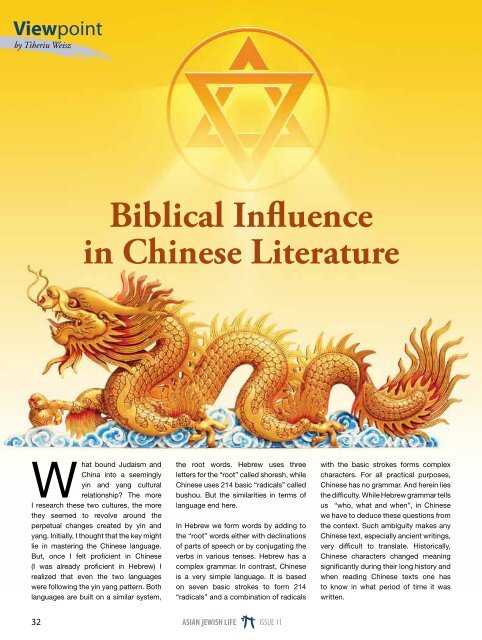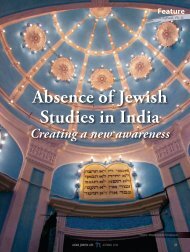Viewpointby Tiberiu WeiszBiblical Influencein Chinese LiteratureWhat bound Judaism andChina into a seeminglyyin and yang culturalrelationship? The moreI research these two cultures, the morethey seemed to revolve around theperpetual changes created by yin andyang. Initially, I thought that the key mightlie in mastering the Chinese language.But, once I felt proficient in Chinese(I was already proficient in Hebrew) Irealized that even the two languageswere following the yin yang pattern. Bothlanguages are built on a similar system,the root words. Hebrew uses threeletters for the “root” called shoresh, whileChinese uses 214 basic “radicals” calledbushou. But the similarities in terms oflanguage end here.In Hebrew we form words by adding tothe “root” words either with declinationsof parts of speech or by conjugating theverbs in various tenses. Hebrew has acomplex grammar. In contrast, Chineseis a very simple language. It is basedon seven basic strokes to form 214“radicals” and a combination of radicalswith the basic strokes forms complexcharacters. For all practical purposes,Chinese has no grammar. And herein liesthe difficulty. While Hebrew grammar tellsus “who, what and when”, in Chinesewe have to deduce these questions fromthe context. Such ambiguity makes anyChinese text, especially ancient writings,very difficult to translate. Historically,Chinese characters changed meaningsignificantly during their long history andwhen reading Chinese texts one hasto know in what period of time it waswritten.32 ASIAN JEWISH LIFE ISSUE 11
Viewpointby Tiberiu WeiszIt is not surprising then, that Chineseand Israelites in antiquity did not haveanything in common and knew nothingabout each other’s culture. Israelitesmight have known about the “land ofSinim” from the Prophet Isaiah. But forthe Chinese, Israelites were just one ofthe unidentified tribes of the uncivilizedyi “barbarian” tribes. In biblical times,the Chinese called every non-Chinese“barbarians”. In this respect, they did notdistinguish between the Mongols or Hunraiders. Nor did they distinguish betweenthe peaceful tribes and settles, traders,and monks who occasionally intermixedwith the Chinese in the north and westof China. Chinese annals portrayedthe “barbarians” as raggedy looking,long red hair, dirty, unshaven and withrepulsive body odor.Yet, a sharp-eyed Chinese sage hadindeed described in one sentence a tribewith a strange custom. He talked abouta tribe that fasted, bathed and cleanedthemselves before praying to God. Thisdescription puzzled Chinese and Westernscholars alike. Who they were eludedan answer for a long time. It puzzledme too, but for a different reason. Thedescription seemed familiar, I just couldnot identify where I had seen that before.Only when I worked on the translation ofthe Kaifeng stone inscriptions and cameupon a similar Chinese sentence, did Irealize that those exact words originatedwith a very influential Chinese sage.Who was that sage?In my book The Kaifeng StoneInscriptions, I traced the journey of a groupof exiled Levites and Cohanim (priests)from Babylon (6th century BCE) to theKingdom of Ferghana (north Afghanistantoday) to the Western Regions andultimately their migration into China inthe second century BCE. The migrationfrom exile to the Western Regions tookperhaps as long as four hundred years.Of course, the exiles themselves werenot the original settlers in China but thedescendants of their descendants were.They were sighted at the outskirts ofChina in the second century BCE, andaccepted the Chinese offer to comeand settle in the Western Regions inreturn for the protection of the Chinese.The Western Regions (xiyu in Chinese)stretched from northern Afghanistan toDunhuang (the Pass in Chinese) in thenortheast of Gansu Province today. Hereended the main trade route, the so calledSilk Road that ran from Syria to CentralAsia, to Northern India, and to the WesternRegions. The Western Regions served asa buffer zone between China proper andthe Mongol/ Hun raiders who frequentlyinvaded and plundered China. To avertor minimize the impact of these raids, theChinese encouraged “barbarian” tribesto settle at the outskirts of China in theWestern Regions.We know very little about these Israeliteswho lived in the Western Regions, at theoutskirts of China for centuries. Mostof our information was based on whatthe Chinese Jews inscribed in stone.Amazingly, after many centuries inisolation, the Jews in China (Kaifeng) stillobserved the precepts of the Torah!Journeying in the vast desert land ofthe Western Regions, were two Chinesesages who had great influence on China.During their travels they might havecome in contact with Israelites, andonly a careful reading of their writinghinted at such an encounter. One of thesages was Mencius (372-289 BCE). Hisinfluence was second only to Confucius.His biography mentioned that late in hislife he left China and had spent twentyyears “beyond the Pass” in the WesternRegions. We know very little of hiswhereabouts or what he did. Most of theinformation is deduced from his writings.Apparently, he encountered a tribe duringhis journey that “fasted and bathed, andthen they sacrificed to Shangdi.” Shangdiwas the Chinese Almighty equal only toElohim. Mencius, like most Chinese ofhis time, did not have a high opinionof the “barbarians” and this tribe wasno exception. His exact words wererather unflattering. He said: “[If] Xizi hadbeen covered in such a filth [alternativetranslation: “with filthy head dress/clothes?], people would hold their noseswhen passing by. Although [those] peoplewere ugly, if they fasted and bathed, thenthey could sacrifice to Shangdi.“It is not coincidental that Mencius usedthe word xizi (pronounced shee-tze). Itmeans: “Son of the West.” And herelies the controversy. Who was Xizi? TheChinese suggested that it was the nameof Lady Xi. But Lady Xi was female andthe suffix zi (son, master) would indicatea male. The Chinese offered a simplesolution; they replaced the character ziwith the character shi (clan) thus clearingthe name for a female name. Thisexplanation is plausible, though I think it isfar fetched. Alternatively, Mencius mighthave used the word Xizi as a derogatoryterm for the tribe that fasted and purifiedthemselves before sacrificing to Shangdiin the Western Region.ASIAN JEWISH LIFE ISSUE 1133













